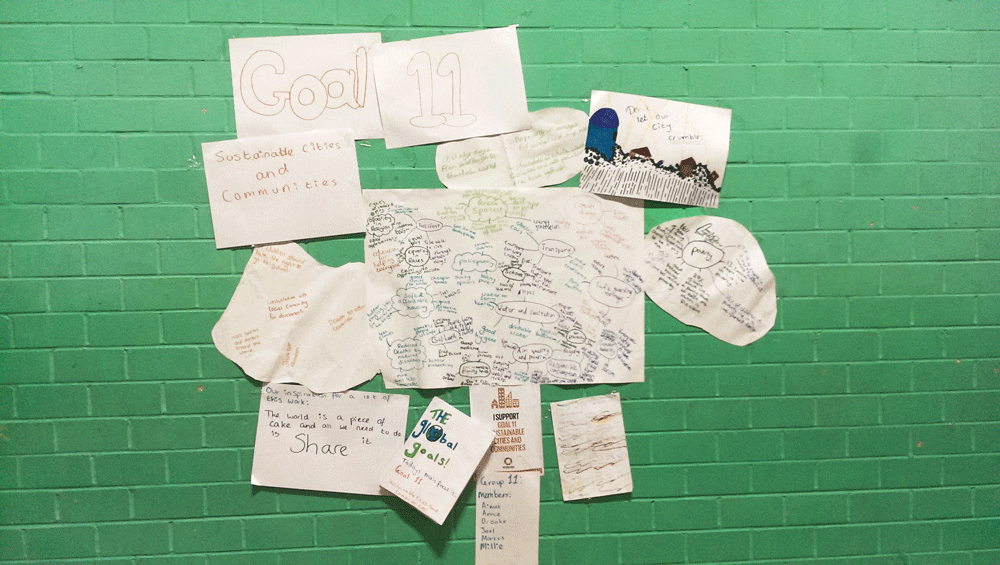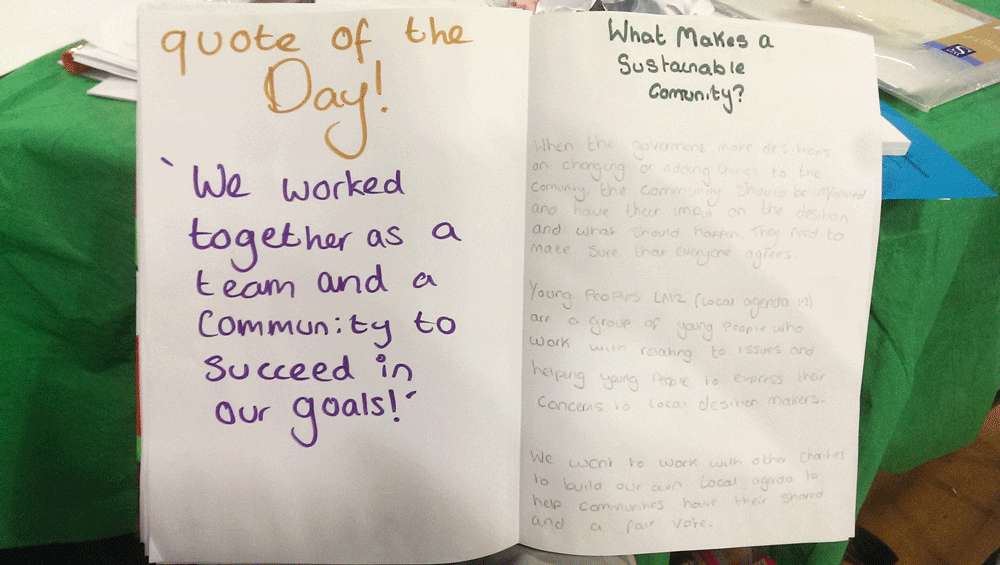Intergenerational learning: making the SDGs work
b y S U E V E N N
The Agenda 2030 forms an ambitious set of long-run goals. Yet, for those most affected, the year 2030 seems like a very long time in the future. How can we make the most of it and involve kids in the SDGs task, Sue Venn asks, reflecting on her participation at a recent Global Goals conference at Ken Stimpson Community School.

In responding to a request from the Ken Stimpson Community School in Peterborough to act as a facilitator at their ‘Global Goals’ conference of 160 year 8 pupils, I found myself working with young people aged 12-14 on the sustainable development goals. Other facilitators came from NGO’s including Frog Life, Save the Children and SHINE, from local government and from businesses interested in sustainable development.
Think… Process… Act… was our remit for the day. Think – to understand the goals and their local, national, and global relevance. Process – to think creatively about what the challenges might be to achieve them, and Act – to explore ways to meet those challenges, as well as disseminating our ideas with the rest of the conference. Along the way, my ‘dream team’ of 5 pupils were thoughtful, creative, co-operative and engaged. Our focus was on goal 11: Sustainable cities and communities, which as more than one of the team observed, had synergies with most of the other goals. Each team member had a pre-determined role as either Ambassador, Lead Researcher, Secretary General, Lead Designer, or Archivist, although in practice these roles shifted as they naturally adopted roles that better suited their own skills. Their creative ideas really needed little guidance as they showed an extraordinary understanding of why these goals are so important for the present, and for their future, as demonstrated by their sobering responses to being asked what Prosperity is, such as “No more terrorists in the world”, “Children having a safe world to grow up in”, and “Everyone gets an equal chance”. I don’t think many adults could improve on these.

One aspect that worked particularly well was the interaction between the teams, the epitome of goal 17 on partnership working, whereby ‘ambassadors’ would circulate and ask questions of other teams and share ideas with them. One team’s approach, for SDG 8 ‘Decent work and economic growth’, was to run a poll asking us all to choose between more jobs or more wages, allowing for a debate on the possibility of what an increase in wages might mean for inequalities within society, or for the students to consider the possibility of a world where more people are able to work, but for fewer hours.
Team SDG 11, as we became, decided to produce a “Global Goals” magazine, and once that decision was made content took off, with articles on homelessness, and pollution, and a thoughtful Leader on “What Makes a Sustainable Community”. One team member even secured a promise of investment for future issues from another team through strategic negotiation. This was a learning experience for all of us, not just the pupils, but for the teachers and facilitators too, as we discovered not only what was most important for these young people, but also their innovative and enthusiastic ideas of how to address the challenges of implementing the goals.
So what is the best way to capture this initiative and keep the momentum going? Well, the teacher who organised the conference is committed to building on the day and continue working with the students, and those of us who attended as facilitators. But we can’t rely solely on a teacher with a passion to make change. Making the goals a part of the learning of every school and ensuring the pertinence of them are transparent not only in local terms, but also nationally and globally, will surely embed the SDG’s in young peoples’ lifelong learning.
We should also be mindful of our expectations. Constantly telling young people that we are relying on them as the means for future change places, I believe, too much pressure on one generation, in spite of evidence that they are clearly more than capable. When you are 13, 2030 seems like a very long time in the future and indeed, my team were bewildered by the very idea of being as old as 28, let alone considering what they might be doing at that age. Instead, we need to do more intergenerational work, working alongside young people, such as took place during the conference, not only in schools, but beyond and into the community – in the spirit of SDG 17.
As Victor Anderson has said in an earlier blog, the SDGs are not perfect, nor is it clear how they will be implemented let alone achieved by 2030. But this sort of initiative was a start, and if we work intergenerationally, taking small steps together towards the SDGs, we may be heading in the right direction.
LINKS
- Sustainable Development Goals
- Ken Stimpson Community School
- Created by Schools Initiative

